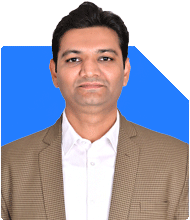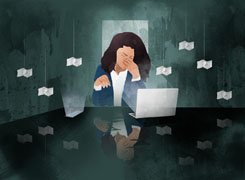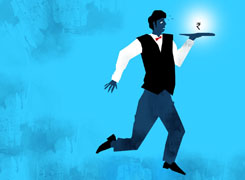31-Year-Old Interior Designer Seeks Wealth-Building Plan by 50
Ramalingam Kalirajan |8285 Answers |Ask -Follow
Mutual Funds, Financial Planning Expert - Answered on Aug 02, 2024
He has an MBA in finance from the University of Madras and is a certified financial planner.
He is the director and chief financial planner at Holistic Investment, a Chennai-based firm that offers financial planning and wealth management advice.... more

hello, my age is 31 year old married. wife is house wife and we have 1 year old daughter alo, i am freelance interior designer, architect from mumbai and earning aprroximate 1.25 lac per month and monthly expenses are approc 30000. i dont have any loan/ dept to pay. currently i have 15 lac in equity market, 10 lac in mutual funds monthly SIP 25000, 2lac in FD, 5lac of gold jewellary, 20 lac of health insurance and 20 lac of Life insurance. please send good planning to make wealth by the age of 50.
Age: 31 years
Family: Married with a homemaker wife and a 1-year-old daughter
Profession: Freelance interior designer and architect
Location: Mumbai
Monthly Income: Rs 1.25 lakh
Monthly Expenses: Rs 30,000
Savings: Rs 95,000 per month
Existing Investments:
Rs 15 lakh in equity market
Rs 10 lakh in mutual funds
Rs 2 lakh in fixed deposits
Rs 5 lakh in gold jewellery
Rs 20 lakh health insurance
Rs 20 lakh life insurance
Financial Goals
Corpus Goal: Rs 5 crore in the next 12-15 years
Wealth Accumulation Goal: By age 50
Financial Strategy
Evaluation of Existing Investments
Equity Market: Rs 15 lakh
Equity investments earn high returns over a long period.
Invest in different sectors to minimize risk.
Mutual Funds: Rs 10 lakh with Rs 25,000 SIP on a monthly basis
One can continue investing through SIP in actively managed funds.
These funds would perform better than index funds as it is expertly managed funds.
Get the services of a CFP to select funds periodically.
Fixed Deposits: Rs 2 lakh
Fixed deposits offer safety but only ordinary returns.
Some of the money could be shifted to betterperforming instruments.
Gold Jewellery: Rs 5 lakh
Gold is an excellent hedge against inflation.
No more money needs to be put into gold as the returns are only good.
Health and Life Insurance: Rs 20 lakh each
Adequate coverage ensures financial security.
Review periodically to check on adequacy of coverage.
Optimising Investments
Increase SIP Amount:
The monthly SIP should be increased from Rs 25,000 to Rs 50,000.
Now, invest in a mix of large-cap, mid-cap and multi-cap funds.
Since actively managed funds have an added advantage in terms of the possibility of higher returns.
Diversify Equity Investments:
Sectors in which you can diversify your Rs 15 lakh equity investments.
You can add in blue-chip stocks for stability.
Invest in sectors that will grow significantly for better returns.
Emergency Fund:
Maintain emergency funding equivalent to 6 months to 12 months of expenditure.
Consider keeping Rs 3-5 lakh in liquid funds or saving bank accounts.
Regular Review:
Review your investment portfolio regularly.
Flow with the market and adjust by financial goals.
Shun Index Funds:
Index funds closely follow the market index and tend to be inferior to active funds
Active funds can adjust to changes in the market and deliver superior returns
Take the help of a Certified Financial Planner
Engage a CFP for customized investment plans
He helps with the right fund choices and portfolio management
Investment Planning for the Long-term
Systematic Transfer Plan (STP):
Get the help of STP to transfer money from low-risk to high return investments.
This will ensure gradual exposure to equity markets.
Child's Education and Future Needs:
Open a separate fund for the education of your daughter.
You can look at some mutual funds that are specifically for children or PPF.
Retirement Planning:
Start retirement planning through targeted investments.
Diversify into retirement-specific mutual funds with steady growth expectations.
Tax Planning:
Invest in tax-saving products such as ELSS mutual funds.
Save on taxes through deductions available under Section 80C.
Final Words
Monitoring Regularly: Track your financial goals and performance of your investments regularly.
Discipline in Savings: Save and invest Rs 95,000 every month regularly.
Avoid Low-Yield Investments: Avoid investing in low-return instruments like excessive fixed deposits.
Professional Guidance: Consult a Certified Financial Planner to optimize your investment strategy.
With these steps, you will be able to achieve your aim of creating a corpus of Rs 5 crore in a span of 12-15 years. A disciplined approach and expert guidance will ensure steady growth.
Best Regards,
K. Ramalingam, MBA, CFP,
Chief Financial Planner,
www.holisticinvestment.in
You may like to see similar questions and answers below
Ramalingam Kalirajan |8285 Answers |Ask -Follow
Mutual Funds, Financial Planning Expert - Answered on May 17, 2024
Ramalingam Kalirajan |8285 Answers |Ask -Follow
Mutual Funds, Financial Planning Expert - Answered on May 27, 2024
Ramalingam Kalirajan |8285 Answers |Ask -Follow
Mutual Funds, Financial Planning Expert - Answered on Jul 27, 2024
Jinal Mehta | Answer |Ask -Follow
Financial Planner - Answered on Jul 26, 2024
Dr Dipankar Dutta |1165 Answers |Ask -Follow
Tech Careers and Skill Development Expert - Answered on Apr 24, 2025
Dr Dipankar Dutta |1165 Answers |Ask -Follow
Tech Careers and Skill Development Expert - Answered on Apr 24, 2025
Dr Dipankar Dutta |1165 Answers |Ask -Follow
Tech Careers and Skill Development Expert - Answered on Apr 24, 2025
Dr Dipankar Dutta |1165 Answers |Ask -Follow
Tech Careers and Skill Development Expert - Answered on Apr 24, 2025
Vipul Bhavsar |58 Answers |Ask -Follow
Tax Expert - Answered on Apr 24, 2025
Radheshyam Zanwar |1563 Answers |Ask -Follow
MHT-CET, IIT-JEE, NEET-UG Expert - Answered on Apr 24, 2025
Radheshyam Zanwar |1563 Answers |Ask -Follow
MHT-CET, IIT-JEE, NEET-UG Expert - Answered on Apr 24, 2025
Sushil Sukhwani |594 Answers |Ask -Follow
Study Abroad Expert - Answered on Apr 24, 2025
Sushil Sukhwani |594 Answers |Ask -Follow
Study Abroad Expert - Answered on Apr 24, 2025
Sushil Sukhwani |594 Answers |Ask -Follow
Study Abroad Expert - Answered on Apr 24, 2025






















